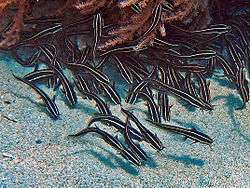Plotosus lineatus
| Plotosus lineatus | |
|---|---|
 | |
| Plotosus lineatus at Bunaken National Park | |
| Scientific classification | |
| Kingdom: | Animalia |
| Phylum: | Chordata |
| Class: | Actinopterygii |
| Order: | Siluriformes |
| Family: | Plotosidae |
| Genus: | Plotosus |
| Species: | P. lineatus |
| Binomial name | |
| Plotosus lineatus (Thunberg, 1787) | |
Plotosus lineatus, common name Striped eel catfish, is a species of eeltail catfishes belonging to the family Plotosidae.
Description
Plotosus lineatus can reach a maximum length of 32 cm (13 in).[1] The body is brown with cream-colored or white longitudinal bands.
The most striking feature of this species is in the fins, in fact the second dorsal, caudal and anal are fused together as in eels. In the rest of the body is quite similar to a freshwater catfish: the mouth is surrounded by four pairs of barbels, four on the upper jaw and four on the lower jaw. The first dorsal and each of the pectoral fins have a highly venomous spine. They may even be fatal.[1]

Juveniles of Plotosus lineatus form dense ball-shaped schools of about 100 fish, while adults are solitary or occur in smaller groups of around 20 and are known to hide under ledges during the day.[1] Adult P. lineatus search and stir the sand incessantly for crustaceans, mollusks, worms, and sometimes fish.[1]
Striped eel catfish is an oviparous fish; this species has demersal eggs and planktonic larvae. This species has evolved long ampullary canals in its electrosensory organs (originally termed "ampullae of Lorenzini").
Distribution and habitat
P. lineatus occurs in the Indian Ocean, in the western Pacific Ocean and sometimes enters freshwaters in East Africa and Madagascar.[1] The species now also occurs in the Mediterranean, having invaded as a Lessepsian migrant through the Suez Canal.[2] P. lineatus is found in coral reefs; it is also found in estuaries, tide pools and open coasts.[1]
References
- 1 2 3 4 5 6 Froese, Rainer and Pauly, Daniel, eds. (2014). "Plotosus lineatus" in FishBase. November 2014 version.
- ↑ Rodríguez, G.; Suárez, H. (2001). "Anthropogenic dispersal of decapod crustaceans in aquatic environments". Interciencia. 26 (7): 282–288.
Bibliography
- Eschmeyer, William N., ed. 1998. Catalog of Fishes. Special Publication of the Center for Biodiversity Research and Information, núm. 1, vol. 1-3. California Academy of Sciences. San Francisco (California). ISBN 0-940228-47-5.
- Fenner, Robert M.: The Conscientious Marine Aquarist. Neptune City, New Jersey: T.F.H. Publications, 2001.
- Helfman, G., B. Collette y D. Facey: The diversity of fishes. Blackwell Science, Malden, Massachusetts, 1997.
- Moyle, P. y J. Cech.: Fishes: An Introduction to Ichthyology, 4a. ed., Upper Saddle River, New Jersey: Prentice-Hall. Año 2000.
- Nelson, J.: Fishes of the World, 3a. ed. New York: John Wiley and Sons. 1994.
- Wheeler, A.: The World Encyclopedia of Fishes, 2a. ed., London: Macdonald. 1985.
- Lieske, E. i R. Myers 1994. Collins Pocket Guide. Coral reef fishes. Indo-Pacific & Caribbean including the Red Sea. Haper Collins Publishers, 400 p.